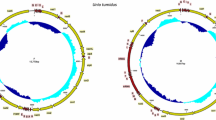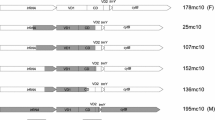Abstract
The mussel Mytilus trossulus is an important component of the Baltic brackish water ecosystem. The genetic structure of mussel (M. trossulus) populations was studied in sites along the Polish coast, Southern Baltic for two segments of mitochondrial DNA (mtDNA). The mode of inheritance of Mytilus mtDNA is termed doubly uniparental; two genomes are passed independently down the female (the F genome) and male (the M genome) lines of descent. The M genome has not been detected at high frequency in M. trossulus, thus the present study focuses on the F genome. PCR and RFLP analysis was used to characterise haplotypes in the coding region ND2-COIII; PCR was used to detect length variants in a major noncoding region. Significant differentiation between populations was observed in the frequency of 24 coding region haplotypes and 14 different length variants. For the three most frequent coding region haplotypes, two (I and III) are associated with the length variants, whereas the third (II) is monomorphic for a single variant of short length. It is suggested that variant II is derived by introgression from a related species, M. edulis, and may be resistant to expansion in the noncoding region. In both regions studied, the Ewens–Watterson test reveals significant deviations from neutrality with an excess of rare variants. This might be due to selection against slightly deleterious variants and is consistent with previously published results for Mytilus taxa. The present study also points towards the potential utility of mtDNA length variation in studies of population differentiation of Mytilus.
Similar content being viewed by others
References
Bell, S. R., 1996. Mitochondrial DNA length variation in the mussel Mytilus. PhD thesis. University of Wales Swansea, U.K.
Cardinale, B. J., M. A. Palmer & S. L. Collins. 2002. Species diversity enhances ecosystem functioning through interspecific facilitation. Nature 415: 426–429.
Ewens, W. J., 1972. The sampling theory of selectively neutral alleles. Theor. Popul. Biol. 5: 87–112.
Felsenstein, J., 1993. PHYLIP (Phylogeny Inference Package), Version 3.5c. Distributed by the author. Department of Genetics, University of Washington, Seattle WA 98195, U.S.A.
Fitch, W. M. & E. Margoliash, 1967. Construction of phylogenetic trees. Science 155: 279–284.
Fuller, K. M. & E. Zouros, 1993. Dispersed discrete length polymorphism of mitochondrial DNA in the scallop Placopecten magellanicus (Gmelin). Current Genetics 23: 365–369.
Gjetvaj, B., D. I. Cook & E. Zouros, 1992. Repeated sequences and large-scale variation of mitochondrial DNA: A common feature among scallops (Bivalvia: Pectinidae). Mol. Biol. Evol. 9: 106–124.
Hoffmann, R. J., J. L. Boore & W. M. Brown, 1992. A novel mitochondrial genome organisation for the blue mussel, Mytilus edulis. Genetics 131: 397–412.
Kimura, M., 1991. Recent development of the neutral theory viewed from the Wrightian tradition of theoretical population genetics. Proc. Nat. Acad. Sci. U.S.A. 88: 5969–5973.
Lunt, D. H., L. E. Whipple & B. C. Hyman, 1998. Mitochondrial DNA variable number tandem repeats (VNTRs): utility and problems in molecular ecology. Mol. Ecol. 7: 1441–1455.
McElroy, D., P. Moran, E. Bermingham & I. Kornfield, 1991. REAP: an integrated environment for the manipulation and phylogenetic analysis of restriction data. J. Hered. 83: 157–158.
Nei, M., 1987. Molecular Evolutionary Genetics. Columbia University Press. New York.
Nei, M. & W.-H. Li, 1979. Mathematical model for studying genetic variation in terms of restriction endonucleases. Proc. Nat. Acad. Sci. U.S.A. 76: 5269–5273.
Ohta, T., 1992. The nearly neutral theory of molecular evolution. Ann. Rev. Ecol. Syst. 23: 263–286.
Quesada, H., M. Warren & D. O. F. Skibinski, 1998. Nonneutral evolution and differential mutation rate of gender-associated mitochondrial DNA lineages in the marine mussel Mytilus. Genetics 149: 1511–1526.
Quesada, H., R. Wenne & D. O. F. Skibinski, 1995. Differential introgression of mitochondrial DNA across species boundaries within the marine mussel genus Mytilus. Proc. r. Soc. Lond. Ser. B, Biol. Sci. 262: 51–56.
Quesada, H., R. Wenne & D. O. F. Skibinski, 1999. Interspecies transfer of female mitochondrial DNA is coupled with rolereversals and departure from neutrality in the mussel Mytilus trossulus. Mol. Biol. Evol. 16: 655–665.
Rigaa, A., M. Monnerot & D. Sellos, 1995. Molecular cloning and complete nucleotide sequence of the repeated unit and flanking gene of the scallop Pecten maximus mitochondrial DNA: putative replication origin features. J. Mol. Evol. 41: 189–195.
Roff, D. A. & P. Bentzen, 1989. The statistical analysis of mitochondrial DNA polymorphisms: ÷2 and the problem of small samples. Mol. Biol. Evol. 6: 539–545.
Rumohr, H., E. Bonsdorff & T. Pearson, 1996. Zoobenthic succession in Baltic sedimentary habitats. Arch. Fish. mar. Res. 44: 179–214.
Schneider, S., D. Roessli & L. Excoffier, 2000. Arlequin ver. 2.000: a software for population genetics data analysis. Genetics and Biometry Laboratory, University of Geneva, Switzerland.
Skibinski, D. O. F., C. Gallagher & C. M. Beynon, 1994. Sex – limited mitochondrial DNA transmission in the marine mussel Mytilus edulis. Genetics 138: 801–809.
Skibinski, D. O. F., C. Gallagher & H. Quesada, 1999. On the roles of selection, mutation and drift in the evolution of mitochondrial DNA diversity in British Mytilus edulis (Mytilidae; Mollusca) populations. Biol. J. linn. Soc. 68: 195–213.
Vainola, R. & M. M. Hvilsom, 1991. Genetic divergence and a hybrid zone between Baltic and North Sea Mytilus populations (Mytilidae: Mollusca). Biol. J. linn. Soc. 43: 127–148.
Warzocha, J., 1995. Classification and structure of macrofaunal communities in the southern Baltic. Arch. Fish. mar. Res. 43: 225–237
Watterson, G. A., 1978. The homozygosity test of neutrality. Genetics 88: 405–417.
Watterson, G. A., 1986. The homozygosity test after a change in population size. Genetics 112: 899–907.
Wenne, R. & D. O. F. Skibinski, 1995. Mitochondrial DNA heteroplasmy in European populations of the mussel Mytilus trossulus. Mar. Biol. 122: 619–624.
Wilding, C. S., A. R. Beamont & J. W. Latchford, 1997. Mitochondrial DNA variation in the scallop Pecten maximus (L.) assessed by a PCR-RLFP method. Heredity 79: 178–189.
Zouros, E., A. O. Ball, C. Saavedra & K. R. Freeman, 1994. An unusual type of mitochondrial DNA inheritance in the blue mussel Mytilus. Proc. Nat. Acad. Sci. U.S.A. 91: 7463–7467.
Author information
Authors and Affiliations
Rights and permissions
About this article
Cite this article
Zbawicka, M., Wenne, R. & Skibinski, D. Mitochondrial DNA variation in populations of the mussel Mytilus trossulus from the Southern Baltic. Hydrobiologia 499, 1–12 (2003). https://doi.org/10.1023/A:1026356603105
Issue Date:
DOI: https://doi.org/10.1023/A:1026356603105




